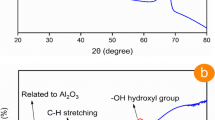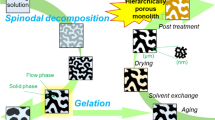Abstract
In this study, we reported effect of alcohol solvents on morphology of hollow silica–alumina composite spheres and their activity for hydrolytic dehydrogenation of ammonia borane. Silica–alumina composite shell was coated on polystyrene template particles via sol–gel reaction in various alcohol solvents. The hollow spheres were prepared in methanol, ethanol and 2-propanol for 36, 17 and 8 h, respectively. The results indicate that the order of sol–gel reaction rate was 2-propanol > ethanol > methanol. Amount of hydrogen evolution of the hollow spheres prepared in methanol and ethanol were higher than that of the hollow spheres prepared in 2-propanol. From the results of solid-state 27Al nuclear magnetic resonance spectra, we found that aluminum species of the hollow spheres prepared in methanol and ethanol were highly dispersed in their silica matrix. The results of temperature programed dispersion of ammonia showed that all the hollow spheres have weak and strong Brønsted acid sites. The amount of weak Brønsted acid sites in all the hollow spheres were of same level, while the amount of strong Brønsted acid sites increase with decrease of sol–gel reaction rate. These results indicate that the sol–gel reaction rate influences the dispersion of aluminum species, and highly dispersed aluminum species lead to increase in the amount of Brønsted acid sites.
Graphical Abstract









Similar content being viewed by others
References
Kalidindi SB, Indirani M, Jagirdar BR (2008) First row transition metal ion-assisted ammonia-borane hydrolysis for hydrogen generation. Inorg Chem 47:7424–7429
Yousef A, Barakat NAM, EL-Newehy MH, Ahmed MM, Kim HY (2015) Catalytic hydrolysis of ammonia borane for hydrogen generationusing Cu(0) nanoparticles supported on TiO2 nanofibers. Colloids Surf A 470:194–201
Graham TW, Tsang C-W, Chen X, Guo R, Jia W, Lu S-M, Sui-Seng C, Ewart CB, Lough A, Amoroso D, Abdur-Rashid K (2010) Catalytic solvolysis of ammonia borane. Angew Chem Int Ed 49:8708–8711
Li P-Z, Aijaz A, Xu Q (2012) Highly dispersed surfactant-free nickel nanoparticles and their remarkable catalytic activity in the hydrolysis of ammonia borane for hydrogen generation. Angew Chem Int Ed 51:6753–6756
Shan X, Du J, Cheng F, Liang J, Tao Z (2014) Carbon-supported Ni3B nanoparticles as catalysts for hydrogen generation from hydrolysis of ammonia borane. Int J Hydrogen Energy 39:6987–6994
Balla M, Wietschel M (2009) The future of hydrogen - opportunities and challenges. Int J Hydrogen Energy 34:615–627
Eberle U, Felderhoff M, Schüth F (2009) Chemical and physical solutions for hydrogen storage. Angew Chem Int Ed 48:6608–6630
Hausdorf S, Baitalow F, Wolf G, Mertens FORL (2008) A procedure for the regeneration of ammonia borane from BNH-waste products. Int J Hydrogen Energy 33:608–614
Zahmakiran M, Özkar S (2009) Dimethylammonium hexanoate stabilized rhodium(0) nanoclusters identified as true heterogeneous catalysts with the highest observed activity in the dehydrogenation of dimethylamine-borane. Inorg Chem 48:8955–8964
Özhava D, Özkar S (2015) Rhodium(0) nanoparticles supported on hydroxyapatite nanospheres and further stabilized by dihydrogen phosphate ion: a highly active catalyst in hydrogen generation from the methanolysis of ammonia borane. Int J Hydrogen Energy 40:10491–10501
Roy B, Manna J, Sharma P (2015) Effect of Ni-alloys on thermal decomposition of ammonia borane. J Alloy Compd 645:S234–S238
Hwang HT, Al-Kukhun A, Varma A (2012) High and rapid hydrogen release from thermolysis of ammonia borane near PEM fuel cell operating temperatures. Int J Hydrogen Energy 37:2407–2411
Demirci UB, Bernard S, Chiriac R, Toche F, Miele P (2011) Hydrogen release by thermolysis of ammonia borane NH3BH3 and then hydrolysis of its by-product [BNHx]. J Power Sources 196:279–286
Kobayashi T, Gupta S, Caporini MA, Pecharsky VK, Pruski M (2014) Mechanism of solid-state thermolysis of ammonia borane: a 15N NMR study using fast magic-angle spinning and dynamic nuclear polarization. J Phys Chem C 118:19548–19555
Wang P (2012) Solid-state thermolysis of ammonia borane and related materials for high-capacity hydrogen storage. Dalton Trans 41:4296–4302
Xu Q, Chandra M (2006) Catalytic activities of non-noble metals for hydrogen generation from aqueous ammonia-borane at room temperature. J Power Sources 163:364–370
Chandra M, Xu Q (2006) Dissociation and hydrolysis of ammonia-borane with solid acids and carbon dioxide: an efficient hydrogen generation system. J Power Sources 159:855–860
Toyama N, Umegaki T, Xu Q, Kojima Y (2014) Control of particle size of hollow silica-alumina composite spheres and their activity for hydrolytic dehydrogenation of ammonia borane. J Jpn Inst Energy 93:511–516
Toyama N, Umegaki T, Kojima Y (2014) Fabrication of hollow silica-alumina composite spheres and their activity for hydrolytic dehydrogenation of ammonia borane. Int J Hydrogen Energy 39:17136–17143
Toyama N, Umegaki T, Kojima Y (2015) Influence of Si/Al molar ratio of hollow silica-alumina composite spheres on their activity for hydrolytic dehydrogenation of ammonia borane. Int J Hydrogen Energy 40:6151–6157
Toyama N, Umegaki T, Kojima Y (2015) Control of particle size of hollow silica-alumina composite spheres prepared using L(+)-arginine and their activity for hydrolytic dehydrogenation of ammonia borane. Trans Mat Res Soc Japan 40:81–84
Umegaki T, Imamura S, Toyama N, Kojima Y (2014) Influence of preparation conditions on the morphology of hollow silica–alumina composite spheres and their activity for hydrolytic dehydrogenation of ammonia borane. Microporous Mesoporous Mater 196:349–353
Yang L, Luo W, Cheng G (2013) Graphene-supported Ag-based core-shell nanoparticles for hydrogen generation in hydrolysis of ammonia borane and methylamine borane. ACS Appl Mater Interfaces 5:8231–8240
Cao N, Hua K, Luo W, Cheng G (2014) RuCu nanoparticles supported on graphene: a highly efficient catalyst for hydrolysis of ammonia borane. J Alloy Compd 590:241–246.
Hu Y, Wang Y, Lu Z-H, Chen X, Xiong L (2015) Core-shell nanospheres Pt@SiO2 for catalytic hydrogen production. Appl Surf Sci 341:185–189
Li Y, Dai Y, Tian X-ke (2015) Controlled synthesis of monodisperse PdxSn100-x nanoparticles and their catalytic activity for hydrogen generation from the hydrolysis of ammonia-borane. Int J Hydrogen Energy 40:9235–9243
Khatri C, Rani A (2008) Synthesis of a nano-crystalline solid acid catalyst from fly ash and its catalytic performance. Fuel 87:2886–2892
Su F, Guo Y (2014) Advancements in solid acid catalysts for biodiesel production. Green Chem 16:2934–2957
Ghimire A, Frunzo L, Pirozzi F, Trably E, Escudie R, Lens PNL, Esposito G (2015) A review on dark fermentative biohydrogen production from organic biomass: process parameters and use of by-products. Appl Energy 144:73–95
Wang C-A, Lia S, An L (2013) Hierarchically porous Co3O4 hollow spheres with tunable pore structure and enhanced catalytic activity. Chem Commun 49:7427–7429
Kang N, Park JH, Jin M, Park N, Lee SM, Kim HJ, Kim JM, Son SU (2013) Microporous organic network hollow spheres: useful templates for nanoparticulate Co3O4 hollow oxidation catalysts. J Am Chem Soc 135:19115–19118
Li M, Xu W, Wang W, Liu Y, Cui B, Guo X (2014) Facile synthesis of specific FeMnO3 hollow sphere/graphene composites and their superior electrochemical energy storage performances for supercapacitor. J Power Sources 248:465–473
Han L, Liu R, Li C, Li H, Li C, Zhang G, Yao J (2012) Controlled synthesis of double-shelled CeO2 hollow spheres and enzyme-free electrochemical bio-sensing properties for uric acid. J Mater Chem 22:17079–17085
Dong F, Guo W, Park S-S, Ha C-S (2011) Uniform and monodisperse polysilsesquioxane hollow spheres: synthesis from aqueous solution and use in pollutant removal. J Mater Chem 21:10744–10749
Studart AR, Gonzenbach UT, Tervoort E, Gauckler LJ (2006) Processing routes to macroporous ceramics: a review. J Am Ceram Soc 89:1771–1789
Nandiyanto ABD, Suhendi A, Arutanti O, Ogi T, Okuyama K (2013) Influences of surface charge, size, and concentration of colloidal nanoparticles on fabrication of self-organized porous silica in film and particle forms. Langmuir 29:6262–6270
Wan H, Long Y, Xu H, Song K, Yang G, Tung C-H (2014) New strategy to prepare hollow silica microspheres with tunable holes on the shell wall. Langmuir 30:683–686
Shen B-H, Hsieh M-L, Chen H-Y, Wu J-Y (2013) The preparation of hollow silica spheres with mesoporous shell via polystyrene emulsion latex template and the investigation of ascorbic acid release behavior. J Polym Res 20:1–11
Nandiyanto ABD, Suhendi A, Ogi T, Umemoto R, Okuyama K (2014) Size- and charge-controllable polystyrene spheres for templates in the preparation of porous silica particles with tunable internal hole configurations. Chem Eng J 256:421–430
Nandiyanto ABD, Suhendi A, Ogi T, Iwaki T, Okuyama K (2012) Synthesis of additive-free cationic polystyrene particles with controllable size for hollow template applications. Colloids Surf A 396:96–105
Fukuoka M, Makishita A (2003) Effects of the type of alcoholic solvent on the formation of SiO2 wet gels in sol-gel process. J Ceram Soc Jpn 111:83–86
Nandiyanto ABD, Akane Y, Ogi T, Okuyama K (2012) Mesopore-free hollow silica particles with controllable diameter and shell thickness via additive-free synthesis. Langmuir 28:8616–8624
Ge C, Zhang D, Wang A, Yin H, Ren M, Liu Y, Jiang T, Yu L (2009) Synthesis of porous hollow silica spheres using polystyrene-methylacrylic acid latex template at different temperatures. J Phys Chem Solids 70:1432–1437
Bao Y, Yang Y, Shi C, Ma J (2014) Fabrication of hollow silica spheres and their application in polyacrylate film forming agent. J Mater Sci 49:8215–8225
Goodwin JW, Ottewill RH, Pelton R (1979) Studies on the prepareation and characterization of monodisperse polystyrene laticesV.: the preparation of cationic latices. Colloid Polym Sci 257:61–69
Qiu L, Qu B (2006) Preparation and characterization of surfactant-free polystyrene/layered double hydroxide exfoliated nanocomposite via soap-free emulsion polymerization. J Colloid Interface Sci 301:347–351
Nazaran P, Tauer K (2007) Nucleation in emulsion polymerization: another step towards non-micellar nucleation theory. Macromol Symp 259:264–273
Kage A, Erica A, Ko H (1993) [Zeta potential of PSL particles in alcohol - water solution]. Kagaku Kougaku Ronbunshu 19:1031–1037
Mine E, Nagao D, Kobayashi Y, Konno M (2005) Solvent effects on particle formation in hydrolysis of tetraethyl orthosilicate. J Sol-Gel Sci Technol 35:197–201
Harris MT, Brunson RR, Byers CH (1990) The base-catalyzed hydrolysis and condensation reactions of dilute and concentrated TEOS solutions. J Non-Cryst Solids 121:397–403
Hao F, Zhong J, Liu P-L, You K-Y, Luo H-A (2012) Amorphous SiO2-Al2O3 supported Co3O4 and its catalytic properties in cyclohexane nitrosation to ε-caprolactam: influences of preparation conditions. J Mol Catal A Chem 363-364:41–48
Fang X, Liu Z, Hsieh M-F, Chen M, Liu P, Chen C, Zheng N (2012) Hollow mesoporous aluminosilica spheres with perpendicular pore channels as catalytic nanoreactors. ACS nano 6:4434–4444
Koekkoek AJJ, Rob van Veen JA, Gerrtisen PB, Giltay P, Magusin PCMM, Hensen EJM (2012) Brønsted acidity of Al/SBA-15. Microporous Mesoporous Mater 151:34–43
Zhuang J, Ma D, Yang G, Yan Z, Liu X, Liu X, Han X, Bao X, Xie P, Liu Z (2004) Solid-state MAS NMR studies on the hydrothermal stability of the zeolite catalysts for residual oil selective catalytic cracking. J Catal 228:234–242
Sakthivel A, Dapurkar SE, Gupta NM, Kulshreshtha SK, Selvam P (2003) The influence of aluminium sources on the acidic behaviour as well as on the catalytic activity of mesoporous H-AlMCM-41 molecular sieves. Microporous Mesoporous Mater 65:177–187
Wang Y, Lang N, Tuel A (2006) Nature and acidity of aluminum species in AlMCM-41 with a high aluminum content (Si/Al = 1.25). Microporous Mesoporous Mater 93:46–54
Acknowledgement
This work was supported by NIMS and University of Tokyo microstructural characterization platform as a program of “Nanotechnology Platform” of the Ministry of Education, Culture, Sports, Science and Technology (MEXT), Japan. We are grateful to Mr. Deguchi and Ms. Wada for using solid-state NMR, and Mr. Ito for using TEM measurement. Additionally, we also thanks Dr. Yoneda for using NH3-TPD measurement.
Author information
Authors and Affiliations
Corresponding author
Ethics declarations
Competing financial interests
The authors declare no competing financial interests.
Rights and permissions
About this article
Cite this article
Toyama, N., Ohki, S., Tansho, M. et al. Influence of alcohol solvents on morphology of hollow silica–alumina composite spheres and their activity for hydrolytic dehydrogenation of ammonia borane. J Sol-Gel Sci Technol 82, 92–100 (2017). https://doi.org/10.1007/s10971-016-4287-6
Received:
Accepted:
Published:
Issue Date:
DOI: https://doi.org/10.1007/s10971-016-4287-6




